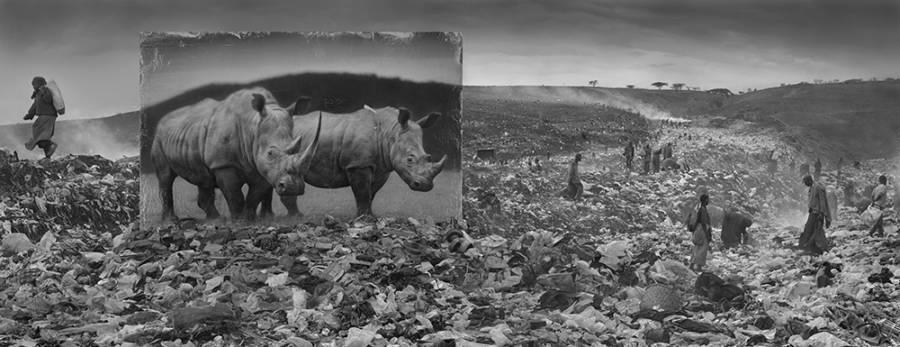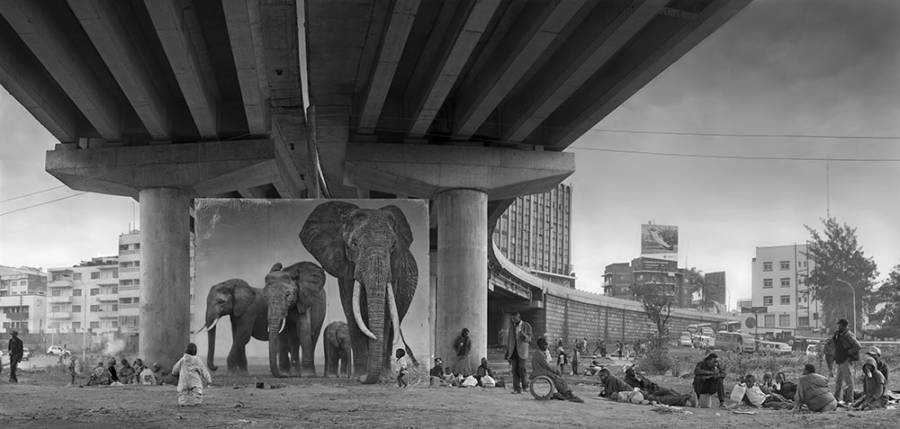Urbanization may hold the key to alleviating poverty, but at what cost can this come?
Nick Brandt wants his woolly rhinoceros back. At least that’s how the English photographer begins his essay on Inherit the Dust, his latest photo project.
Unfortunately for Brandt, centuries of industrialization and urban development in the chilly isle mean that the rhino — along with a host of other animals who once called England home — will never return. “Glorious creatures, a wonder to behold as they roamed across the hills and forests of southern England,” Brandt writes. “Of course, this was before my time.”

© Nick Brandt, courtesy Edwynn Houk Gallery, New York“Wasteland With Elephant 2015”
Given its ongoing trend of urbanization, Brandt fears that the phrase “before my time” will only gain prominence in Africa. Indeed, the World Bank estimates that 50 percent of Africans will live in urban spaces by 2030 — and that growth, as the African Development Bank Group notes, may come at a price. “The expansion of cities,” ADBG writes, “is generally at the expense of destruction of forests and other natural environment or ecosystems, and increasing pollution.”
With this in mind, in 2014 Brandt set out to “re-introduce” animals whose habitats have been lost to urbanization. To do so, Brandt traveled to urban zones throughout East Africa, where he placed life-size photos he had taken of elephants, zebras, and chimpanzees among them. Brandt would then photograph his two-dimensional subjects amid their new environments: African elephants underneath overpasses, chimpanzees sitting in alleyways, zebras in slums.
While initially about the ecological costs of development, Brandt says the photo series quickly became about people and the challenges they face in an urbanizing and urbanized Africa as well. When writing about his photo “Underpass with Elephants,” for instance, Brandt spends the most time describing the people — not the life-size elephant panel — in the photo.
“They are all homeless, even the mothers with very young children and babies, who sleep beneath this underpass encircled by a central Nairobi roundabout,” Brandt writes. “The poisoned icing on the cake in relation to the homeless people is the cruelly juxtaposed billboard beyond, featuring a well-to-do middle class African man leaning back in a chair in his garden, with the tag line beneath: Lean Back, Your Life is On Track.”
Brandt’s observation highlights a general challenge the area faces and will continue to face as more people move to cities. While it is true that, as economist Edward Glaeser notes, “cities are the best path we know out of poverty,” it is also true that unless urbanization comes with investments in infrastructure, institutions and systems that make these cities competitive, poverty levels are unlikely to abate.
In the meantime, Brandt — who recognizes that his views as a “privileged white guy from the West” may not matter much to those actually grappling with these problems in a very real way — hopes that his series reminds viewers that, for better or worse, the ecological costs of growth are shared across time and place:

© Nick Brandt, courtesy Edwynn Houk Gallery, New York“Road to Factory with Zebra 2014”

© Nick Brandt, courtesy Edwynn Houk Gallery, New York“Quarry with Lion 2014”

© Nick Brandt, courtesy Edwynn Houk Gallery, New York“Wasteland with Rhinos 2015”

© Nick Brandt, courtesy Edwynn Houk Gallery, New York“Quarry with Giraffe 2014”

© Nick Brandt, courtesy Edwynn Houk Gallery, New York“Factory With Rhino 2014”

© Nick Brandt, courtesy Edwynn Houk Gallery, New York“Underpass with Elephants (Lean Back, Your Life is on Track) 2015”
If you want to get behind the scenes of the Inherit the Dust series, check out the video below:
Next, learn about Agbogbloshie, Ghana, where illegal e-waste dumping poses a grave environmental and public health hazard. Then, check out the stunning wildlife photography of Will Burrard-Lucas.





